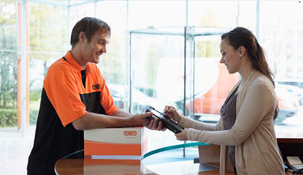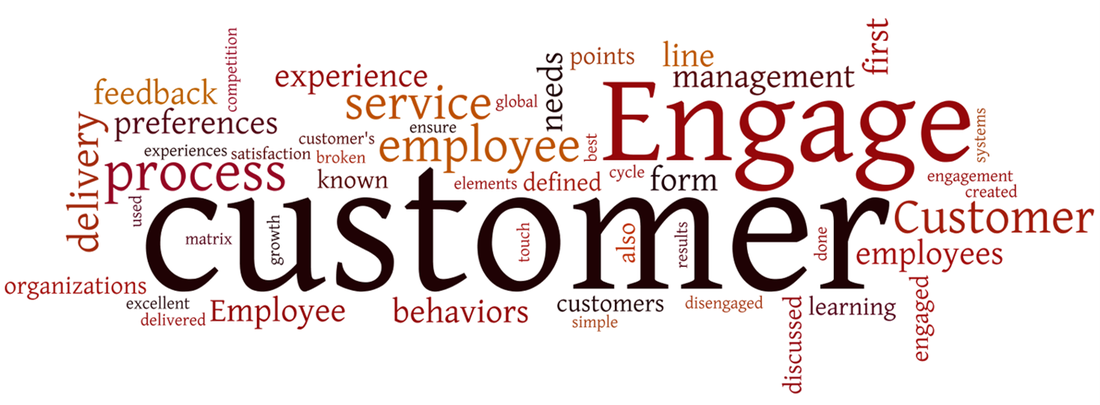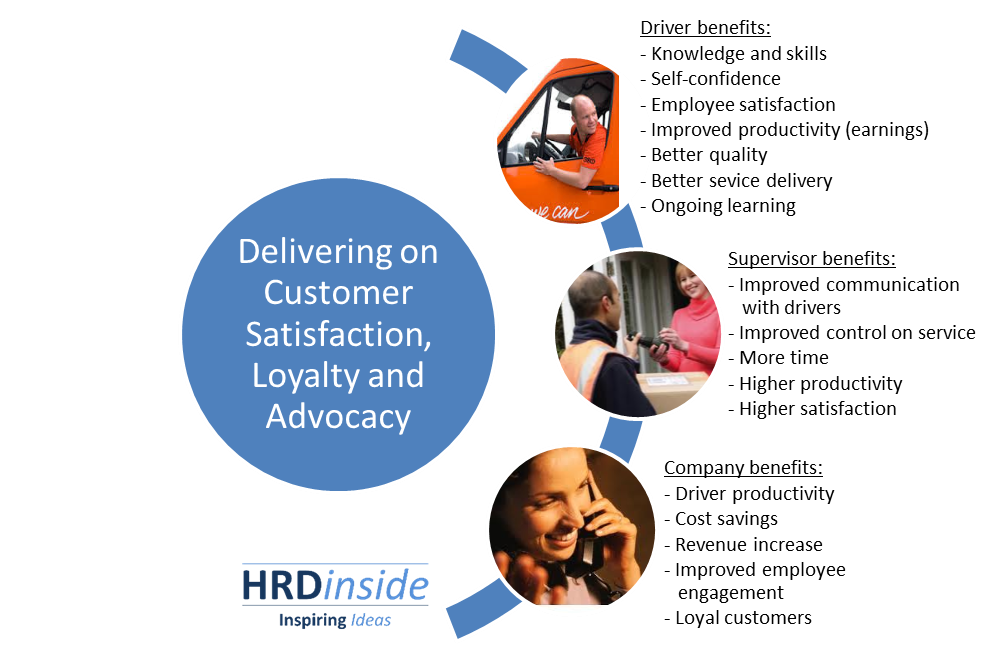Engage or die!
Employee and Customer engagement are one of the best differentiators for your organisation. But only if you manage this well.
Employee and customer experiences must be managed together -- not as separate entities. Emotions drive and shape the employee-customer encounter. Some key conclusions from "Human Sigma" a great book I strongly recommend. Also, Gallup reported already in 2011 that only 29% of employees are actively engaged. The ration of engaged employees to disengaged employees is 9.6 : 1 in world-class organisations. In actively disengaged organisations the ratio is 1.8 : 1.
Benefits:
Delivery drivers felt far more engaged and capable of dealing with individual customer requirements. Supervisors felt being more in control of drivers, as well as managing customer service through smarter operations. Supervisors also reported having more time available, which they could use really well. Customers said they were happy to provide feedback on drivers, which allowed drivers to build confidence and develop themselves even more. Ongoing measurements showed a steadily rising curve, indicating the improving customer experience
After 6 months: 10% increase in both customer and employee satisfaction.
Find out how to engage and beat your competition. Read about a project developed in a global parcel delivery company that made the difference in the end.
Employee and customer experiences must be managed together -- not as separate entities. Emotions drive and shape the employee-customer encounter. Some key conclusions from "Human Sigma" a great book I strongly recommend. Also, Gallup reported already in 2011 that only 29% of employees are actively engaged. The ration of engaged employees to disengaged employees is 9.6 : 1 in world-class organisations. In actively disengaged organisations the ratio is 1.8 : 1.
Benefits:
Delivery drivers felt far more engaged and capable of dealing with individual customer requirements. Supervisors felt being more in control of drivers, as well as managing customer service through smarter operations. Supervisors also reported having more time available, which they could use really well. Customers said they were happy to provide feedback on drivers, which allowed drivers to build confidence and develop themselves even more. Ongoing measurements showed a steadily rising curve, indicating the improving customer experience
After 6 months: 10% increase in both customer and employee satisfaction.
Find out how to engage and beat your competition. Read about a project developed in a global parcel delivery company that made the difference in the end.
Developing delivery drivers to create the best customer experience
To ensure service delivery creates the best customer experience possible, we first ensured we understood the customer's needs. In fact, we extended this beyond the usual facts, and made sure we were differentiating from the competitors. Therefore customers were involve in the employee learning cycle which improved the service delivery continuously.
Excellent Customer Experience can only be delivered when:
The way services were delivered to customers was broken down to "customer touch points". These can be defined as any part of a process that influences a customer experience. This is of course the physical delivery of a service at the customer location, but could also be sending an invoice, contacting customer service, a sales visit, or even handling customer's property in your supply chain (e.g. sorting the parcel).
Once the Customer touch points were known and verified, we started exploring them in terms of customer needs and preferences. This in the end resulted in a list of customer critical behaviors for drivers. We defined these for each step in the process, e.g. what are the behaviors that make the customer experience an excellent service?
To ensure service delivery creates the best customer experience possible, we first ensured we understood the customer's needs. In fact, we extended this beyond the usual facts, and made sure we were differentiating from the competitors. Therefore customers were involve in the employee learning cycle which improved the service delivery continuously.
Excellent Customer Experience can only be delivered when:
- All customer needs and preferences are known
- Processes and systems are aligned and based on these
- Employee behaviours are aligned with customer needs and preferences
- Customer feedback is provided on employee behaviour
- First-line management is empowered to collect and provide this feedback
- Customer Service is aligned with the process of supervisors calling customers and asking for feedback on the service.
The way services were delivered to customers was broken down to "customer touch points". These can be defined as any part of a process that influences a customer experience. This is of course the physical delivery of a service at the customer location, but could also be sending an invoice, contacting customer service, a sales visit, or even handling customer's property in your supply chain (e.g. sorting the parcel).
Once the Customer touch points were known and verified, we started exploring them in terms of customer needs and preferences. This in the end resulted in a list of customer critical behaviors for drivers. We defined these for each step in the process, e.g. what are the behaviors that make the customer experience an excellent service?

In the last step, behaviors were broken down to simple elements, which can be understood and easily learned by employees. It is also important to ensure this can be explained by first line management (supervisors).
A good example is the "4-2-1st-last" rule we introduced. The meaning of this rule was to remember to start smiling 4 meters before facing the customer, make eye contact at 2 meters, be the first to say good morning and the last to greet "have a nice day" on departure. All behavioral element were broken down this way, but with a solid explanation of the "why" and "how's".
When the above is done for each step in the process, a reference matrix is created which describes the behaviors that ensure customer satisfaction. By combining this with customer preferences, a check list of behavioral elements, process steps and/or systems that support the process will allow training and coaching guidelines for first line management.
We also created a video (25 minutes in total) which was based on the customer critical behaviors, the processes, the systems and last but not least, the daily practice and burdens of a delivery driver. This really makes the difference for supervisors. They can illustrate all aspects of the pick-up or delivery, including how to deal with customers.
The same matrix is used to create a customer feedback form, which first line management will use immediately after a service delivery. Through a 5 minutes phone call, the first line manager fills a feedback form through asking predefined questions to the customer. Of course the call also ensures the customer satisfaction is measured. This allows for measuring the improving customer engagement per driver. But also per vertical market, per area in a country, etc. The company now also has a tool to track the implementation of the program, the results, and with some of the open questions asked to customers, identify local service and sales opportunities.
The feedback form is discussed with the driver during the same day and positive experiences of the customer are shared. One or maximum two learning points are discussed and new actions agreed. During this 15 minutes session, also the previous action plan is reviewed and discussed. The drivers loved this. Although we thought this would be the tough part, it worked out to be the easiest part of the program. Finally drivers could hear what customers say about them, what they like and don't. It also provided a good platform for supervisors to discuss various aspects of not only the driver's behavior in front of the customer, but also in general.
When this is done for each driver every month, a continuous learning cycle is embedded in the daily working process.
We were also able to make this applicable to other employees. Customers can be found for each employee, as internal customers can be involved just as easy as external customers.
A good example is the "4-2-1st-last" rule we introduced. The meaning of this rule was to remember to start smiling 4 meters before facing the customer, make eye contact at 2 meters, be the first to say good morning and the last to greet "have a nice day" on departure. All behavioral element were broken down this way, but with a solid explanation of the "why" and "how's".
When the above is done for each step in the process, a reference matrix is created which describes the behaviors that ensure customer satisfaction. By combining this with customer preferences, a check list of behavioral elements, process steps and/or systems that support the process will allow training and coaching guidelines for first line management.
We also created a video (25 minutes in total) which was based on the customer critical behaviors, the processes, the systems and last but not least, the daily practice and burdens of a delivery driver. This really makes the difference for supervisors. They can illustrate all aspects of the pick-up or delivery, including how to deal with customers.
The same matrix is used to create a customer feedback form, which first line management will use immediately after a service delivery. Through a 5 minutes phone call, the first line manager fills a feedback form through asking predefined questions to the customer. Of course the call also ensures the customer satisfaction is measured. This allows for measuring the improving customer engagement per driver. But also per vertical market, per area in a country, etc. The company now also has a tool to track the implementation of the program, the results, and with some of the open questions asked to customers, identify local service and sales opportunities.
The feedback form is discussed with the driver during the same day and positive experiences of the customer are shared. One or maximum two learning points are discussed and new actions agreed. During this 15 minutes session, also the previous action plan is reviewed and discussed. The drivers loved this. Although we thought this would be the tough part, it worked out to be the easiest part of the program. Finally drivers could hear what customers say about them, what they like and don't. It also provided a good platform for supervisors to discuss various aspects of not only the driver's behavior in front of the customer, but also in general.
When this is done for each driver every month, a continuous learning cycle is embedded in the daily working process.
We were also able to make this applicable to other employees. Customers can be found for each employee, as internal customers can be involved just as easy as external customers.
Have you created or used similar solutions for creating excellent customer experience, please share this below. If you leave your e-mail address in the contact form, I will send you a small eBook which I wrote on this program.
Subscribe to our newsletter and stay up-to-date with new posts, news flashes, etc. Only once a month!


